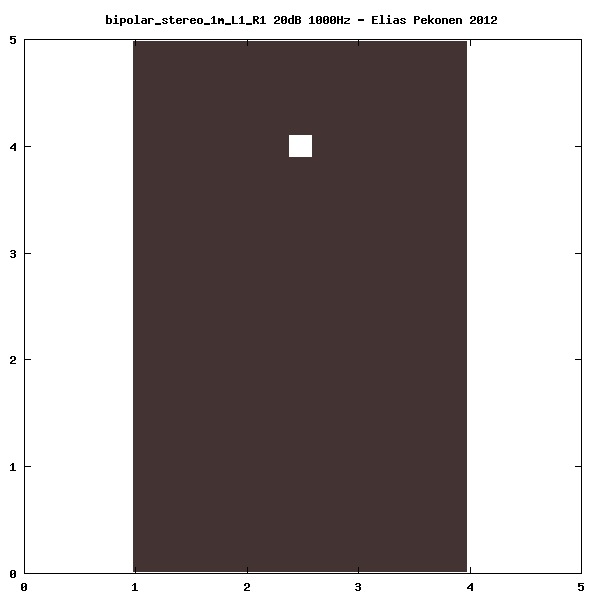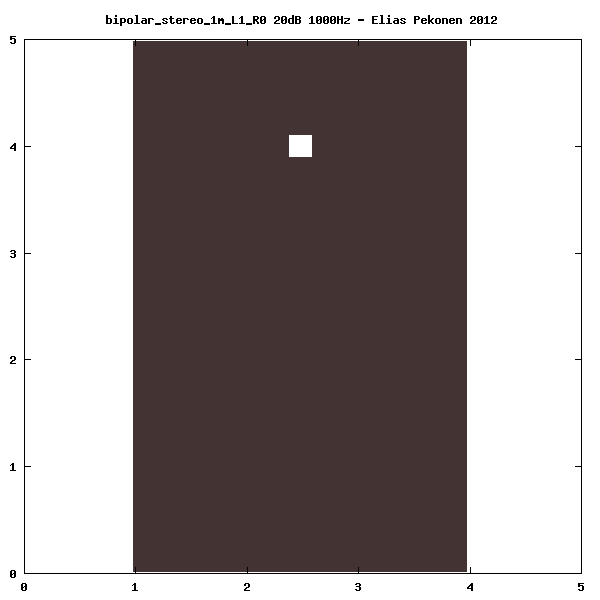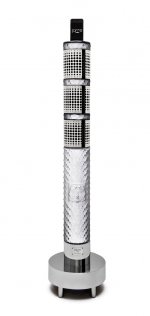Here's a FDTD soundfield simulation of the bipolar stereo speaker in room at 1 kHz.
Center panning L=1 R=1:

Left panning L=1 R=0:

If compared to SSS, in the case of left panning the bipolar stereo speaker has higher leaked direct sound to reflected sound ratio. Likely for that reason I found obligatory to use absorbing barrier to attenuate the direct sound.
Notice the dB scales of these simulations.
- Elias
Center panning L=1 R=1:

Left panning L=1 R=0:

If compared to SSS, in the case of left panning the bipolar stereo speaker has higher leaked direct sound to reflected sound ratio. Likely for that reason I found obligatory to use absorbing barrier to attenuate the direct sound.
Notice the dB scales of these simulations.
- Elias
Last edited:
They're not showing up properly. 🙁
You mean the Ninjas ? 😀
What could be the problem though cannot see pics from photobucket or ?

Er...
I suppose the sim should be like those in the post #356 & 357, with some wavefronts, no?
In post #361, I just saw two blank black rectangles, with a white dot in them each.
I suppose the sim should be like those in the post #356 & 357, with some wavefronts, no?
In post #361, I just saw two blank black rectangles, with a white dot in them each.
Er...
I suppose the sim should be like those in the post #356 & 357, with some wavefronts, no?
In post #361, I just saw two blank black rectangles, with a white dot in them each.
Yes they are animated gif files. Strange. Does it help if you right click on the picture and 'open to new tab' ?
Ah, I saw them.
It's my browser can't display the .gif file properly. I saved the files into my HD, then they can be played by ACDSee. 🙂
It's my browser can't display the .gif file properly. I saved the files into my HD, then they can be played by ACDSee. 🙂
It's my browser can't display the .gif file properly. I saved the files into my HD, then they can be played by ACDSee. 🙂
Wow what a poor browser 😱 Time for a software update for you 😛
Then you propably cannot see the gif animations here either ?
Elias Pekonen Home Page - FDTD simulations on Single Speaker Stereo SSS
It's a company's PC, and it's OK now 😱 (there's a setting which was turned off)
Say, would you please make a sim including the following situations:
1. Lateral room layout (width > depth).
2. Speaker near the front wall. (the wall in front of listener= on the back of spk)
Thanks in advance 🙂
Say, would you please make a sim including the following situations:
1. Lateral room layout (width > depth).
2. Speaker near the front wall. (the wall in front of listener= on the back of spk)
Thanks in advance 🙂
Say, would you please make a sim including the following situations:
1. Lateral room layout (width > depth).
2. Speaker near the front wall. (the wall in front of listener= on the back of spk)
Thanks in advance 🙂
1. can be done without much dificulty. Which kind of ratio is reasonable ? I think SSS consept is not optimal if the room is much wider than long, but I could be wrong since I'm only using the concept in a longitudal configuration (like in the simulations).
2. I have done already 🙂 The simulation results would indicate the very nearby front wall reflection distorts the finesse of the wavefront but does not inhibit the basic matrix steering operation. In my room I've been listening SSS attached to the front wall and in soundwise the difference is small compared a longer distance (1m) from the front wall.
1. Lateral room layout (width > depth).
. . .
At some point, the room will be too wide (or the listener will be to close to the enclosure), and fidelity will give way to novelty. Ideally, the lateral wavefront(s) reach the listener at the same time as the one from the center (when the program intends it; the panned signals in Elias's sims is perfect). While the disturbance threshold varies greatly with program material, pretty much all the experts agree that things change greatly after 15-20 ms. I'd want to keep it way shorter than that, well below 10 ms if possible.
With increasing delay to the lateral reflection(s) you eventually achieve a nearly mono front signal with a seperate effects from the sidewalls. Interesting effects, but zero imaging accuracy.
What I've experimented with a little bit, and would like to see sims for is placement of the SSS away from the wall, w/center firing rearward toward the front wall. This reduces/eliminates the lowpass filtering needed, and provides (adjustable) delay to the mid signal. Just how diffuse or solid the mid image is in this setup depends on all the usual variables-- speaker directivity, wall finish, distance from wall, etc. While too big of an enclosure blocks its own reflection, a small width with limited directivity allows direct sound to radiate around the enclosure to the listener. This is where the sims at different frequencies would be the most helpful.
In the experiments I've tried, I can say that a really huge, deep, soundstage that still images is possible with the right package. In many rooms, however, the center may get too easily colored by the room to be beneficial.
-- Mark
Last edited:
How about 4:3 ?
According to the previous sims, it's foreseeable that the wide-shallow room will be worse. I'd like to see how bad it'd be.
Thanks a lot🙂
According to the previous sims, it's foreseeable that the wide-shallow room will be worse. I'd like to see how bad it'd be.
Thanks a lot🙂
What I've experimented with a little bit, and would like to see sims for is placement of the SSS away from the wall, w/center firing rearward toward the front wall. This reduces/eliminates the lowpass filtering needed, and provides (adjustable) delay to the mid signal. Just how diffuse or solid the mid image is in this setup depends on all the usual variables-- speaker directivity, wall finish, distance from wall, etc. While too big of an enclosure blocks its own reflection, a small width with limited directivity allows direct sound to radiate around the enclosure to the listener. This is where the sims at different frequencies would be the most helpful.
In the experiments I've tried, I can say that a really huge, deep, soundstage that still images is possible with the right package.
now that's a great idea!

In many rooms, however, the center may get too easily colored by the room to be beneficial.
-- Mark
moreover - the center turned towards the listener suffers from vertical reflections
What I've experimented with a little bit, and would like to see sims for is placement of the SSS away from the wall, w/center firing rearward toward the front wall. This reduces/eliminates the lowpass filtering needed, and provides (adjustable) delay to the mid signal. Just how diffuse or solid the mid image is in this setup depends on all the usual variables-- speaker directivity, wall finish, distance from wall, etc. While too big of an enclosure blocks its own reflection, a small width with limited directivity allows direct sound to radiate around the enclosure to the listener. This is where the sims at different frequencies would be the most helpful.
Initially I experimentedwithout the center element. While the sound was very spacious the center image was not very well focused. That's when the centerelementcame inthe picture.
Now if the center element is on the back, there will be very little of direct sound at the treble. Let's remember that the psychoacoustic filter affects only about 5dB or so, and that is enough to allow side images as well.
Instead if the treble attenuation is very large we are back to similar situation like in two element case, and we find our shelvesin the starting point 🙂
Initially I experimentedwithout the center element. While the sound was very spacious the center image was not very well focused. That's when the centerelementcame inthe picture.
Now if the center element is on the back, there will be very little of direct sound at the treble. Let's remember that the psychoacoustic filter affects only about 5dB or so, and that is enough to allow side images as well.
Instead if the treble attenuation is very large we are back to similar situation like in two element case, and we find our shelvesin the starting point 🙂
the situation is not exactly the same and we do not need any "pillow" which means simpler design and better looks
Now if the center element is on the back, there will be very little of direct sound at the treble. Let's remember that the psychoacoustic filter affects only about 5dB or so, and that is enough to allow side images as well.
'Understood.
Spectrum adjustments must be made to account for reflection losses.
As my post was already too long, I removed one particularly important point that may have given you doubt about my understanding of SSS:
What makes the SSS psychoacoustic filter special is not general tonal shaping of the center, but treble steering. No treble is removed from the total picture, it's simply redirected to the sides.
This point didn't really sink-in for me in the beginning. Some of what the filter achieves - decorrelation of some center info to make the center speaker 'disappear', harder to localize - can be achieved by using a reflective center. As the center is broadened and diffused a bit, the filter becomes less critical.If one needs to keep the treble steering filter, the center treble (lost in both the reflection and steering process) can be offset via brighter center driver(s), added tweeter, or other passive means. For example, a piezo tweeter with (adjustable) shunt resistor would be infinitely tune-able for sensitivity to steering.
While relocating the center to a virtual source (the front wall), won't offer the pin-point center image of a direct speaker, it can improve the localization of off-center images due to improved timing with the delayed lateral signals. As a virtual source, the front wall is more 'like' the the virtual side sources.
As long as one can avoid too much center interaction with sidewalls, you can expect a centered, frontal image, that still provides the needed info for the brain to process imaging and what is correlated or de-correlated.
Just some thoughts.
It's always a game of tradeoffs, and any system that is so room dependent makes for variable results. A reflected center, like SSS, won't work well in some rooms.
--Mark
What makes the SSS psychoacoustic filter special is not general tonal shaping of the center, but treble steering. No treble is removed from the total picture, it's simply redirected to the sides.
Yes this is exactly what the filter does 🙂
While relocating the center to a virtual source (the front wall), won't offer the pin-point center image of a direct speaker, it can improve the localization of off-center images due to improved timing with the delayed lateral signals. As a virtual source, the front wall is more 'like' the the virtual side sources.
It is like you say. Definitely I need to do some experiments on this !
Just some thoughts.
It's always a game of tradeoffs, and any system that is so room dependent makes for variable results. A reflected center, like SSS, won't work well in some rooms.
--Mark
In some rooms without a well defined front wall, and if the speaker is placed very close to the front wall there might be some issues if the center element is on the back.
In some rooms without a well defined front wall, and if the speaker is placed very close to the front wall there might be some issues if the center element is on the back.
Many (most?) rooms will present some challenges, to be sure. The reflected center will be fussier for placement than when direct.
If one has to place it close to the wall it's better to just keep it direct -- the center delay will be too short to be worthwhile.
How about a reversible SSS? Switch from filter A to B, remember to swap left and right inputs, and Voila! One can have their SSS on the wall or "off-the-wall". 😉
-- Mark
Last edited:
Another thing to consider if the center element is on the back side, for mono signal the delay will be frequency dependent as lower freqs diffract around the box directly to the listening position but higher freqs get reflected from the front wall.
If the center element is on the front side, no such anomaly occurs.
If the center element is on the front side, no such anomaly occurs.
Hello Elias,
Good work here. Can you please direct me to the exact wiring scheme that you used to implement the "0.5" attenuation.
There are some similarities here to the Haas effect to extract surround ambient signals using L-R or R-L and sent to surround speakers.
Good work here. Can you please direct me to the exact wiring scheme that you used to implement the "0.5" attenuation.
There are some similarities here to the Haas effect to extract surround ambient signals using L-R or R-L and sent to surround speakers.
- Home
- Loudspeakers
- Multi-Way
- Stereophonic Sound from a Single Loudspeaker
